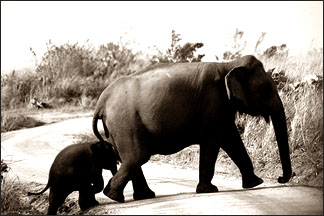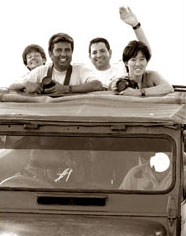Elephants and animals in the park
Tourist attractions in the Walawe Basin:
by Gamini G. Punchihewa
 With the celebrated opening of the Park on the Red Letter Day of
15.9.1980 to the public, another significant event is still etched in my
memory repository stretching back to 27 long years ago. With the celebrated opening of the Park on the Red Letter Day of
15.9.1980 to the public, another significant event is still etched in my
memory repository stretching back to 27 long years ago.
It was the ever grandest of the grandest welcome accorded to us by
these 'Goliaths' of the jungle, congregating in a vast assembly of
elephants and their off-spring. It was also a spectacular dramatic show
of gratitude of their virtual redemption from the ravages of undue
harassment and probable displacement of their 'tribe' perpetrated on
them by the cruel hands of man!
This glorious spectacle was enacted at the enchanting riverine spot
of Thimbirimankade where the flowing Walawe ganga debouches its ruddy
waters into the Uda Walawe reservoir. It was here at this enlivened
spot, where they greeted us with a salute of trumpets echoing far and
wide shattering the stiuness of the sylvan solitude.
This bewitching Thimbirimankade is also the choicest watering place
of not only these 'Monarchs' of this vast wilderness, but also of the
other comrades, like the roaming deer, wandering sambhur, wild boar
stalking leopard, even the diminutive barking deer (olu muwa) trotting
about, and still more of flocks of our feathered denizens.
They all in all in an ensemble ambled there to quench their thirst
and to frolic in the Walawe ganga rearing down its rapid over rockpools
and rock boulders. At this alluring riverine side and its tank graces a
delightful cozy Park Bungalow put up by the Department of Wild Life
Conservation after the inaugural of the park.
Out of the three Park bungalows, this tranquil bungalow is located in
a bewitching place to capture not only its rapturous scenery, but also
wild animal birds abounding there at so close quarters.
In this family herd of elephants, we counted 15 adults, a few
juveniles in the company of four babies. The 'gang' scented man's
presence, sniffed the air with their trunks raised up. Instinct came to
their forte. The adults, 'aunties', 'Uncles', mothers and fathers,
bunched together with the off spring in forming like a 'protective
shield'.
 They protectively wedged them in the middle as 'a physical protective
armour', assured that the intruders foraged into their 'forest
homeland', when they promptly vanished into the jungle thicket with a
'volley' of shrill trumpets. They protectively wedged them in the middle as 'a physical protective
armour', assured that the intruders foraged into their 'forest
homeland', when they promptly vanished into the jungle thicket with a
'volley' of shrill trumpets.
In this pachydermal 'contingent' we observed that there were five
adults, while the whole assembly comprised three grown ups, two
juveniles quenching their thirst with a trunkful of water.
The next episode was splendid and awe-inspiring sans any offence by
word of mouth or any body movements, but ambled slowly but steadily
close to us. We were so elated that a group of elephants which had the
temerity to come within ear-shot and eye-shot distance exhibited
confidence in them that assured well for adventure with thrills.
Enraptured by this rare sight of warm hospitality extended towards
us, we stayed there till sun down. When we were about to leave this
spell-bound scene when the departing elephants orchestrated their
farewell to us with a flourish of trumpets that broke the stillness of
the woodlands.
An ideal Safari
The most exciting safari is to start off mid-day taking some scrap
lunch or some short eats. From the gateway entrance to the park by the
main road, lies an electric fence constructed abutting the main road (on
the left hand side) of the park to keep off the raiding elephants from
entering the Sevanagala Sugar Cane Plantations, while the homestead lots
of the sugar cane growers lie just opposite it, thus confronting the
'man-elephant conflict'!
Through the arbour of the teak plantations inside the park bordering
the electric fence, looming over there, where elephants in singles,
small herds could be observed browsing from the main road side, then
also one two deer strutting across.
In once instance in the past I happened to go pass that way last
year, to my astonishment I spotted a huge lone elephant lying close to
the fence being hand fed by some boys (from the sugar plot homes),
opposite, with sugar cane shoots.
They without any trepidation armed with small sugar cane shoots
holding them in their hands extended them to the jumbo which it gulped
down with gusto. The boys have named it fondly as Raja.
The moment they sighted the loner than they shouted its name crying
Raja, Raja, when it came running towards the boys swaying its body to
and from extending the sugar shoots which it took away gleefully with
shrill trumpets so as to say 'Thank You' don't forget to come again
like! I heard from the Game staff that owing to any unto ward mishaps
occurring, they warned the boys to keep off from feeding them by hand
with such sugar cane shoots in that dangerously proned manner.
This stretch of the park road from its main gate runs into about ten
miles terminating at Veheramankade sheltering the picturesque water shed
lined by towering Kumbuk trees. Under the canopy of these sheltering
trees visitors to the park could pause here for a while to have some
splashes in the flowing crystal clear waters and dip themselves to enjoy
a refreshing bath.
Through Quilts of Managrass
Across the mantle of the dense mana grass, flocks of spotted deer
could be observed with delight as they could be seen merrily leaping in
quick succession. The din of an approaching vehicle would cause them to
come to an abrupt halt looking in all innocence here and there all
alert, and then gallop away into the jungle cover.
By the side of the Park roads ramifying here and there, a majestic
sambhur with a fine pair of antlers looming, slowly but suspiciously
looking here and there always on the alert and then fled away
laboriously carrying its heavy pair of antlers, as if it was a great
burden on it. Here also one would be rewarded by the most enticing sight
of 'proudly' peacocks, one or two at sun rise, exhibiting their bloom of
feathers in full bloom to entice its female partner!
Jungle fowls are a restless lot, they could be seen strutting to and
fro among the plains or undergrowth, only to flee away when a passing
vehicle went past then trailing its gorgeous of feathers would fly over
and take refuge on some high forest perch.
In this exciting but wonderous sights of wildlife, the wild boar at
the slightest sound, would be running all over the forest floor grunting
all its way with their coiled tails tilted up running away in all fright
but anger as well! While a huge crocodile with its hideous jaws wide
open happily basking away under the high noon.
Bear has been sighted by the Game Staff in the upstream of the
Veheragala area, while, the stalking spotted leopard is also sighted
around Sinuggala. While roving around with the Game Staff travelling in
a jeep we spotted it lying on a rockoutcrop close to Sinuggala.
Favourite elephant perchs
Alidutugala on the main park road coming from the main entrance is
the favourite 'Beat' of these roving elephants, particularly the loner (thaniya)
and the inseparable 'Thunpath Rela', the gang of father and mother
elephant with a baby shielding in between in their elephant walks along
the parkland!
The next high perch lies on a big rockoutcrop called Gonaviddagala
close to Thimbirimankade and Sinuggala. It is a safe perch on a higher
elevation. I could still how many happy days I had enjoyed in the
company of the Game staff perched on these two rockoutcrops Alidutugala
and Gonaviddagala capturing with my eyes herds of elephants browsing
silently below with their off spring. In its midst were deer, sambhur,
barking deer, wild bear, jackal.
This stretch of the parkland is punctuated with patches and patches
of the fast growing plant called Lantana forest (Gadapana). It has
turned into a veritable menace to the high mana grass, as when these
Lantana forests survive, the mana grass gets decimated. It's the fodder
for the elephants. It cannot be eradicated by spraying agro-chemicals,
as it would have harmful effects not only on the existing other species
of flora, but even animals and avi-fauna.
Last year in mid 2006, I happened to meet its Warden then, Mr. Upali
Pathmasiri - a very amiable but receptive officer.
He disclosed to me that he had mustered the support of the
schoolchildren drawn from schools in its vicinity like the Uda Walawe
Maha Vidyalaya to eradicate it manually by uprooting the Gadapana
plants, where there was ready response, while the Walawe Basin Lions
Club also had extended its co-operation.
Even the Park Office, already employed manual labourers for this work
of uprooting the Gadapana plants manually. |
